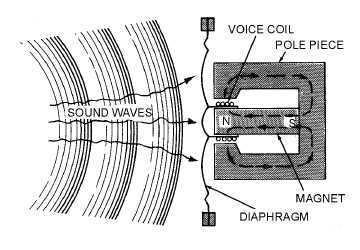1-40
A crystal microphone has a high impedance and does not require an external voltage source. It can
be connected directly into the input circuit of a high-gain amplifier. However, because its output is low,
several stages of high-gain amplification are required. Crystal microphones are delicate and must be
handled with care. Exposure to temperatures above 52 degrees Celsius (125 degrees Fahrenheit) may
permanently damage the crystal unit. Crystals are also soluble in water and other liquids and must be
protected from moisture and excessive humidity.
DYNAMIC MICROPHONE.—A cross section of the DYNAMIC or MOVING-COIL
MICROPHONE is shown in figure 1-35. A coil of fine wire is mounted on the back of the diaphragm and
located in the magnetic field of a permanent magnet. When sound waves strike the diaphragm, the coil
moves back and forth cutting the magnetic lines of force. This induces a voltage into the coil that is an
electrical reproduction of the sound waves.
Figure 1-35.—Dynamic microphone.
The sensitivity of the dynamic microphone is almost as high as that of the carbon type. It is
lightweight and requires no external voltage. The dynamic microphone is rugged and can withstand the
effects of vibration, temperature, and moisture. This microphone has a uniform response over a frequency
range that extends from 40 to 15,000 hertz. The impedance is very low (generally 50 ohms or less). A
transformer is required to match its impedance to that of the input of an af amplifier.
MAGNETIC MICROPHONE.—The MAGNETIC or MOVING-ARMATURE MICROPHONE
(figure 1-36) consists of a coil wound on an armature that is mechanically connected to the diaphragm
with a driver rod. The coil is located between the pole pieces of the permanent magnet. Any vibration of
the diaphragm vibrates the armature at the same rate. This varies the magnetic flux in the armature and
through the coil.


